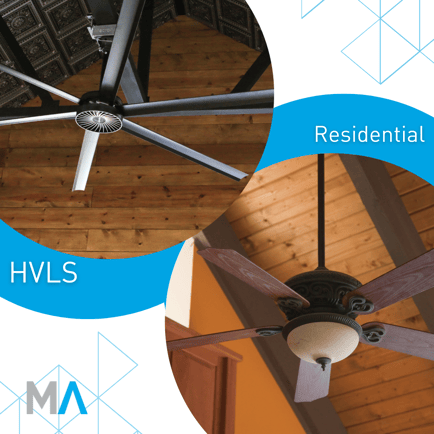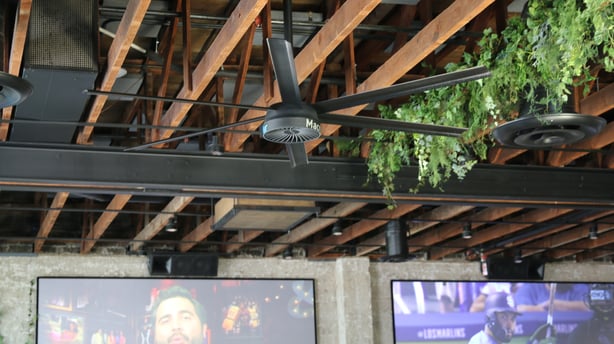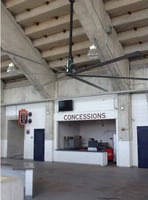With summer fast approaching, people are ready to purchase a new fan for their restaurant, gym, or...
Small Ceiling Fans vs HVLS Ceiling Fans

If you're considering adding a fan to your home, shop, or commercial space, you may be wondering whether to go with a traditional residential ceiling fan or a high-volume, low-speed (HVLS) fan. Both types of fans provide efficient airflow and have their own unique features and benefits. Still, it's important to understand the differences between the two in order to make an informed decision. In this blog post, we'll delve into the differences between residential ceiling fans and HVLS fans, and provide a comparison of the two to help you choose the best option for your space.
Table of Contents
What is a Residential/Small Ceiling Fan?
Comparison of Residential Fans vs HVLS FansWhat is a Small/Residential Fan?
Residential or small ceiling fans are a popular choice for cooling and circulating air in homes and small commercial spaces. They are designed to be mounted on the ceiling of a room and typically come in a variety of styles and sizes to match the decor of the space. Standard residential ceiling fans are powered by motors that run at high speeds, which helps them to quickly circulate air and provide a cool breeze.
Small ceiling fans are a good choice for smaller spaces, as they are easy to install and relatively low cost. A switch or remote control can control them, and many modern residential ceiling fans come with additional features such as built-in lighting or reversible motors for year-round use.
Key Features
Reversible blades
Many residential ceiling fans come with reversible fan blades that can be used to circulate air in both directions. This feature allows you to use the fan to cool a space during the summer and to circulate warm air during the winter.
Multiple speed settings
Most modern ceiling fans come with multiple speed settings, allowing you to adjust the speed of the fan to suit your needs. This feature can be useful for fine-tuning the amount of air circulation in a space, and for conserving energy when a higher fan speed is not needed.
Remote controls
Many residential ceiling fans come with simple remote controls that allow you to adjust the speed and direction of the fan from a distance. This feature can be convenient if you have hard-to-reach switches and allows you to control the fan without getting up from your seat.
What is an HVLS Fan?

An HVLS (high-volume, low-speed) fan is an industrial-grade ceiling fan that is designed for use in larger commercial and industrial spaces. However, they are also designed for use in large residential areas as well as outdoor patio spaces. They are typically much larger in size than residential ceiling fans, with blades that can range from 6 to 24 feet in length. Despite their size, HVLS fans operate at low speeds, typically between 40 and 90 revolutions per minute (RPM). They also operate at a very quiet decibel level.
HVLS fans are designed to provide a gentle, cooling breeze over a wide area. They work by bringing the air down towards the floor then out and around, covering the entire room. Running one HVLS fan can affect a person’s perceived temperature by 15°. In addition to helping to cool the air, HVLS fans can also help to reduce energy costs by circulating warm air trapped near the ceiling, which can help to improve the overall energy efficiency of the space.
Key Features
Large size
One of the key features of an HVLS (High Volume Low Speed) fan is its large size. They are much larger than residential ceiling fans, with diameters ranging from 6 feet to 24 feet. This makes them well-suited for large, open spaces with high ceilings, such as warehouses, distribution centers, and commercial spaces like shops, garages, restaurants, bars, airports, and hangars.
Indoor/Outdoor Operations
HVLS fans are indoor/outdoor rated ceiling fans. This means they can work just as effectively in outdoor spaces. MacroAir Fans offers blades that are made of anodized aluminum, which makes them rust and corrosion-resistant. In addition, the direct drive HVLS fans' motor housing is completely sealed and protected from the elements.
High volume, low speed air movement
HVLS fans are designed to move a large volume of air at a low speed, which can create a comfortable, cool breeze in a large space. Because of the low speed, they operate at a very quiet decibel level. This makes them an effective alternative to smaller fans or heating and cooling systems, which may not be able to provide adequate air circulation in a large space.
Advanced features
Many HVLS fans come with advanced features that can be useful in commercial and industrial settings. These may include variable speed settings, automatic shut-off timers, temperature control, and remote controls for easy operation. Some HVLS fans may also come with features such as customization in color, drop length, and mount options.
Comparison of Residential/Small Fans vs. HVLS Fans

Now that we've covered the basics of residential and HVLS fans, let's take a closer look at some of the key differences between the two.
Size and Ceiling Height:
One of the most obvious differences between residential and HVLS fans is the size and scale. Residential ceiling fans are designed for use in smaller spaces as they are available at 42”-72” inch diameters. They are typically mounted on a standard ceiling height of 8-9 feet.
In contrast, HVLS fans are designed for use in large commercial and industrial spaces with higher ceiling heights as they are available at 6-24 foot diameters. HVLS fans have much longer fan blades creating a powerful airflow, making them more suitable for larger, more open spaces. They can accommodate taller ceiling heights, but can generally be hung as low as 12 ft.
Energy Efficiency
Another key difference between residential and HVLS fans is energy efficiency. While both types of fans can help to reduce energy costs by circulating air and improving overall energy efficiency, HVLS fans are much more energy efficient due to their low speed operation and ability to cover a wider area for pennies a day. Even though HVLS fans are often more expensive upfront, they can provide long-term energy savings due to their increased efficiency.
Functionality and Remote Controls
Both residential ceiling fans and HVLS fans can be controlled using a variety of methods, including remote controls, wall switches, and smart home devices. Residential ceiling fans often come with remote controls that allow you to adjust the speed and direction of the fan from a distance, as well as turn it on and off. Generally, they do not offer customization options.
HVLS fans also typically come with remote controls, as well as other advanced features such as variable speed settings, temperature controls, reverse function, and automatic shut-off timers. They also offer customization for drop length, mount options, color, and remote controls.
Air circulation and distribution
Both types of fans can be effective at creating a cool breeze in a space. Residential ceiling fans are typically best suited for smaller, enclosed spaces, where they can circulate air and provide a cooling effect. The coverage is more directional, and the cooling effect covers a smaller area.
HVLS fans, on the other hand, are designed to move a large volume of air, making them ideal for large, open spaces with high ceilings. This makes HVLS fans a good option for warehouses, distribution centers, and other commercial spaces where a cool breeze is needed throughout the space. The 6-8 foot diameters also work in large residential spaces and outdoor areas.
Durability
When it comes to longevity, both residential ceiling fans and HVLS fans can have a long lifespan if they are well-maintained and used properly. However, HVLS fans may have an advantage in terms of durability and longevity due to their industrial-grade construction, especially in harsher environments with higher humidity levels.
Price
Regarding price, residential ceiling fans are generally more affordable than HVLS fans. Prices for residential ceiling fans can range from $50 to several hundred dollars, depending on the size and features of the fan. In contrast, prices for HVLS fans can range from several hundred to several thousand dollars, depending on the size and features of the fan.
HVLS fans are more energy-efficient than smaller residential fans, which can help to reduce energy costs in the long run. Therefore, the upfront cost of an HVLS fan is offset by long-term energy savings by using less power and producing less heat.
So, while residential ceiling fans may be a more affordable option for smaller, enclosed spaces, HVLS fans may be worth the extra investment for large, open spaces with high ceilings. These big ceiling fans can provide a comfortable, cool breeze throughout a space, and can be more energy-efficient and convenient to use than smaller fans.
Final Thoughts

Residential ceiling fans are a popular choice for smaller, enclosed spaces, and are generally more affordable and energy-efficient than HVLS fans. However, if you have a large, open space with high ceilings, such as a warehouse or distribution center, HVLS fans may be a better option. These industrial ceiling fans are designed to move a large volume of air at a low speed, providing a comfortable, cool breeze throughout the space. While HVLS fans are typically more expensive than residential ceiling fans, they can be a cost-effective solution for large spaces where they can replace multiple smaller fans. Ultimately, the best choice for your space will depend on your needs, budget, and the size and layout of your space.
We at MacroAir are the inventors of the HVLS fan. The OG! We look forward to showcasing our line of HVLS fans to you. There is a solution for every type of space. Click the link below to learn more about each fan option.



